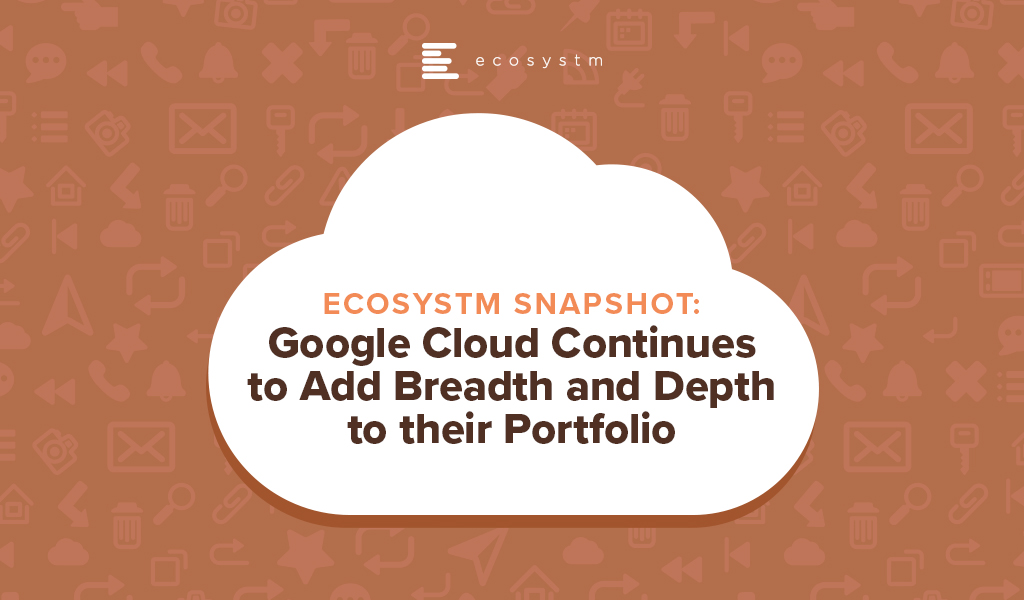
Talking about the top 5 global cloud players – Microsoft, AWS, Google, Alibaba and IBM – in the Ecosystm Predicts: The Top 5 Cloud Trends for 2020, Ecosystm Principal Analyst, Claus Mortensen had said, “their ability to compete will increasingly come down to expansion of their service capabilities beyond their current offerings. Ecosystm expects these players to further enhance their focus on expanding their services, management and integration capabilities through global and in-country partnerships.” Google Cloud is doing just that. The last week has been busy for Google Cloud with a few announcements that show that it is ramping up – adding both depth and breadth to their portfolio.
Expanding Data Centre Footprint
This year Google Cloud is set to expand the number of locations to 26 countries. Earlier in the year, Google CEO Sundar Pichai had promised to invest more than US$ 10 billion in expanding their data centre footprints in the USA and they have recently opened their Salt Lake City data centre. Last week Google announced four new data centre locations in Doha (Qatar), Toronto (Canada), Melbourne (Australia), and Delhi (India). With Australia, Canada and India, Google appears to be following the same policy they followed in Japan – where locations in Osaka and Tokyo give customers the option to have an in-country disaster recovery solution. Doha marks Google Cloud’s first foray into the Middle East. While the data centre will primarily cater to global clients, Google has noted a substantial interest from customers in the Middle East and Africa.
Mortensen says, “Google’s new data centres can be seen as an organic geographical expansion of their cloud services but there are a few more factors at play. With data privacy laws getting stricter across the globe, the ability to offer localised data storage is becoming more important – and India is a very good example of a market where keeping data within the geographical borders will become a must.”
“The expansion will also help the development of Google’s own edge computing services going forward. As we noted in our Ecosystm Predicts document, we believe that Cloud and IoT will drive edge computing (which is tightly tied to 5G). Edge computing will function in a symbiotic relationship with centralised data centres where low latency is important. The geographical expansion of Google’s data centre presence will thus also help their push towards edge computing services.”
Google offers their cloud infrastructure and digital transformation (DX) solutions to customers in 150 countries. Not only are they expanding their data centre footprint, but they are also creating industry differentiation. They have targeted industry-specific solutions that deliver new digital capabilities in 6 key verticals – financial services; telecommunications media and entertainment; retail; healthcare and life sciences; manufacturing and industrial; and public sector.
Partnering with Telecom Providers
Last week also saw the unveiling of the Global Mobile Edge Cloud (GMEC) aimed at the telecom industry’s need to transform and the challenges it faces. The telecom industry – long considered an enabler of DX in other industries – stands at a crossroads now. It is time for the industry to transform in order to succeed in a challenging market, newer devices and networking capabilities, and evolving customer requirements – both consumer and enterprise. Talking about the impact of 5G on telecom providers, Ecosystm Principal Advisor, Shamir Amanullah says, “5G is an enterprise play and leading tech giants, carriers and the companies in the ecosystem are collaborating and inking partnerships in order to create solutions and monetise 5G opportunities across industries.”
Google Cloud announced a partnership with AT&T, which is meant to leverage AT&T’s 5G network and Google Cloud’s edge compute technologies (AI and machine learning, analytics, Kubernetes and networking) to develop a joint portfolio of 5G edge computing solutions. This is part of Google’s larger strategy of supporting telecom providers in their efforts to monetise 5G as a business services platform. Through the GMEC, Google Cloud will partner with carriers to offer a suite of applications and services at the edge via 5G networks.
The telecom industry is a key focus as Google aims to help operators take 5G to market, by creating solutions and services that can be offered to enterprises. This includes better customer engagement through data-driven experiences, and improvement of operational efficiencies across core telecom systems. Telecom providers such as Vodafone and Wind Tre are leveraging Google to improve customer experience through data-driven insights.
Amanullah says, “Google Cloud already has thousands of edge nodes inside the carrier networks which will be enabled for use by enterprises, providing access to data analytics, AI and machine learning capabilities. Carriers can offer enterprises these data-driven solutions, to transform the customer experience they offer. Google will also create solutions which will enable carriers and enterprises to improve infrastructure and operational efficiencies through modern cloud-based Operations Support Systems (OSS) and Business Support Systems (BSS).”
Mortensen also thinks that the data centre expansion should be seen in the light of Google’s GMEC push. “Both India and the Middle East are big potential markets via the local telecom providers.”






